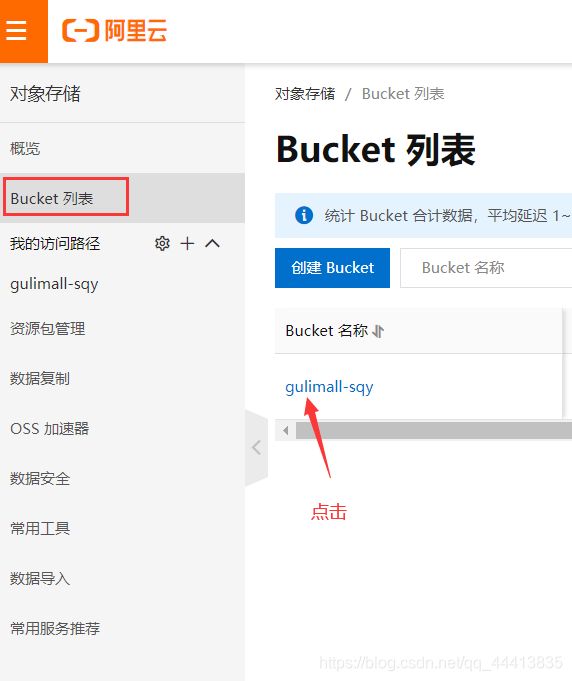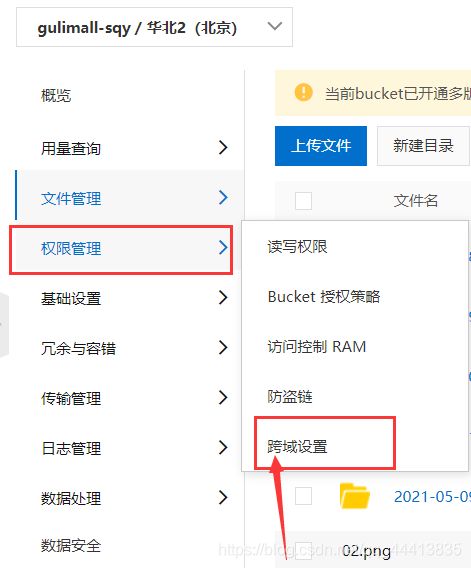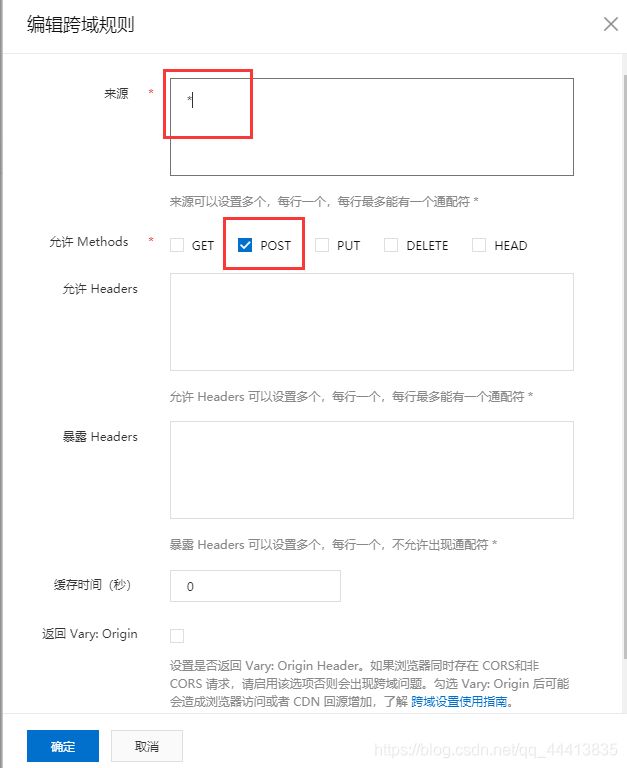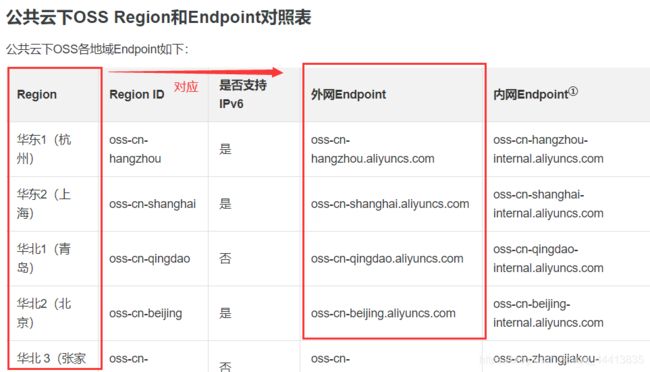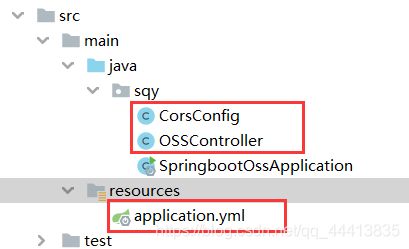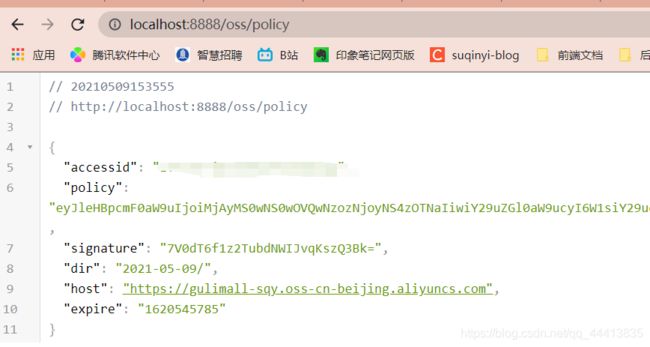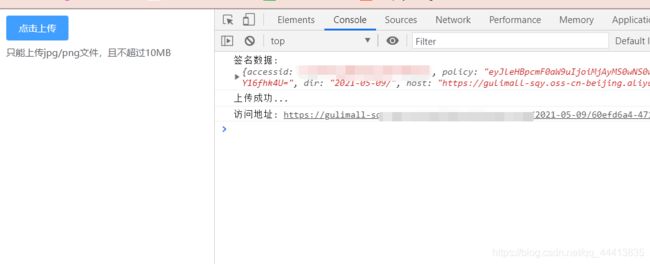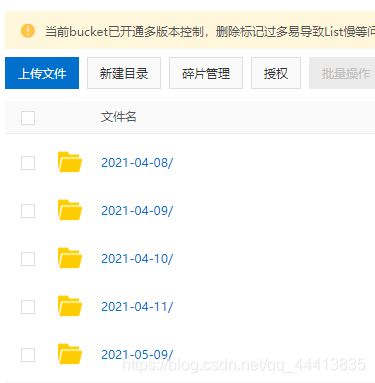springboot整合OSS阿里云上传文件(上传回调方式)
文章目录
- 一、阿里oss服务的开通
-
- 小编说几个注意点
-
- 1、开启oss端的跨域步骤如下
- 2、权限的读写配置
- 3、创建子AccessKey
- 二、如何从文档入手编程
- 三、小编的案例是服务端签名直传并设置上传回调
-
- 3.1、什么意思?
- 3.2、pom文件引入依赖
- 3.3、在application.yml配置相关的数据
- 3.4、创建OSSController生成密钥
- 3.5、配置跨域
- 3.6、目录结构
- 3.7、测试生成密钥的接口
- 四、前端使用
-
- 4.1、说明
- 4.2、页面效果
- 4.3、完整页面代码
- 4.4、上传效果
- 4.5、oss上面的效果,文件在文件中
- 4.6、如何显示图片
- 五、如何清理oss上面不要的图片
- 六、其实小编个人不推荐这种做法
-
- 推荐取消自动上传,将文件和数据一起提交到后台处理
一、阿里oss服务的开通
可以参考下这个博客,记录的基本完全 ==> 文章入口
小编说几个注意点
1、开启oss端的跨域步骤如下
2、权限的读写配置
3、创建子AccessKey
很重要:在使用中,创建子AccessKey,这样安全,记得给他配置响应的权限,例如oss权限
二、如何从文档入手编程
01、阿里oss官网示例文档 ==> 入口
02、Alibaba Cloud OSS Example提供的示例 ==>入口
有那些比较重点的如图:
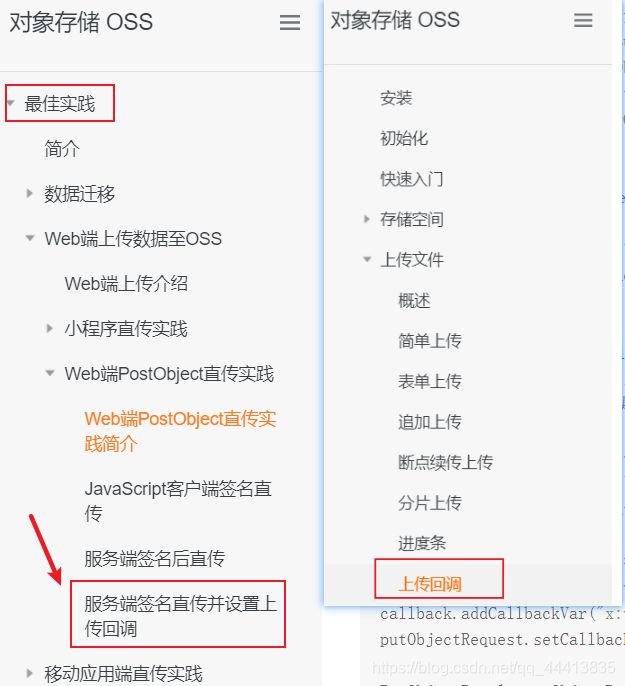
在github上,看示例(如果github缓慢,或者连接不了,自行百度教程,更改下本地的配置)

三、小编的案例是服务端签名直传并设置上传回调
3.1、什么意思?
- 不将文件上传到后端
- 访问后端接口生成密钥,前端拿密钥,将文件直接上传到阿里云储存
- 好处:后端就不需要读取文件速度快,使用密钥也安全
- 言归正传直接上案例说明
代码如下(示例):
3.2、pom文件引入依赖
说明:注意springcloud版本和springboot版本要适配起来
详情看小编这篇博客==>文章入口
简单图示一下:
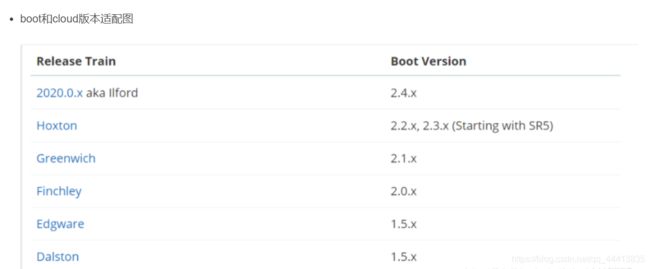
完整的pom文件==>小编使用的版本是2.1.8.RELEASE+Greenwich.SR3
<?xml version="1.0" encoding="UTF-8"?>
<project xmlns="http://maven.apache.org/POM/4.0.0" xmlns:xsi="http://www.w3.org/2001/XMLSchema-instance"
xsi:schemaLocation="http://maven.apache.org/POM/4.0.0 https://maven.apache.org/xsd/maven-4.0.0.xsd">
<modelVersion>4.0.0</modelVersion>
<parent>
<groupId>org.springframework.boot</groupId>
<artifactId>spring-boot-starter-parent</artifactId>
<!--版本-->
<version>2.1.8.RELEASE</version>
<relativePath/>
</parent>
<groupId>sqy</groupId>
<artifactId>springboot_oss</artifactId>
<version>0.0.1-SNAPSHOT</version>
<name>springboot_oss</name>
<description>整合Spring-Cloud-Alibaba的文件上传-OSS</description>
<properties>
<!--jdk版本-->
<java.version>1.8</java.version>
<!--版本-->
<spring-cloud.version>Greenwich.SR3</spring-cloud.version>
</properties>
<dependencies>
<!--oss依赖-->
<dependency>
<groupId>com.alibaba.cloud</groupId>
<artifactId>spring-cloud-starter-alicloud-oss</artifactId>
</dependency>
<!-- web应用-->
<dependency>
<groupId>org.springframework.boot</groupId>
<artifactId>spring-boot-starter-web</artifactId>
</dependency>
<!--test-->
<dependency>
<groupId>org.springframework.boot</groupId>
<artifactId>spring-boot-starter-test</artifactId>
<scope>test</scope>
</dependency>
</dependencies>
<!--版本控制-->
<dependencyManagement>
<dependencies>
<!-- springcloud-->
<dependency>
<groupId>org.springframework.cloud</groupId>
<artifactId>spring-cloud-dependencies</artifactId>
<version>${spring-cloud.version}</version>
<type>pom</type>
<scope>import</scope>
</dependency>
<!-- spring-cloud-alibaba-->
<dependency>
<groupId>com.alibaba.cloud</groupId>
<artifactId>spring-cloud-alibaba-dependencies</artifactId>
<version>2.1.0.RELEASE</version>
<type>pom</type>
<scope>import</scope>
</dependency>
</dependencies>
</dependencyManagement>
<build>
<plugins>
<plugin>
<groupId>org.springframework.boot</groupId>
<artifactId>spring-boot-maven-plugin</artifactId>
</plugin>
</plugins>
</build>
</project>
3.3、在application.yml配置相关的数据
小编采用的是yml格式,也可以使用application.properties
spring:
cloud:
alicloud:
access-key: 你的ak
secret-key: 你的sk
oss:
endpoint: 你的对外服务的访问域名
bucket: 你的存储空间
#应用名称
application:
name: springboot_OSS
#端口
server:
port: 8888
- ak和sk就是你申请的了(最好是创建子AccessKey)
- 如何看endpoint(对外服务的访问域名)==> 看选择的地域 ==>查看入口
3.4、创建OSSController生成密钥
为什么是注入是 OSS 而不是 OssClient 原因请看小编这篇文章==>文章入口
在测试类中注入OssClient 是不会报错的,在controller会
package sqy;
import com.aliyun.oss.OSS;
import com.aliyun.oss.common.utils.BinaryUtil;
import com.aliyun.oss.model.MatchMode;
import com.aliyun.oss.model.PolicyConditions;
import org.springframework.beans.factory.annotation.Autowired;
import org.springframework.beans.factory.annotation.Value;
import org.springframework.web.bind.annotation.RequestMapping;
import org.springframework.web.bind.annotation.RestController;
import javax.annotation.Resource;
import java.text.SimpleDateFormat;
import java.util.Date;
import java.util.LinkedHashMap;
import java.util.Map;
/**
* @author suqinyi
* @Date 2021/5/9
*/
/**
* 说明:
* 官网介绍:https://help.aliyun.com/document_detail/91868.htm
*/
@RestController
public class OSSController {
@Resource
@Autowired(required = false)//单纯去掉红色下划线,强迫症
OSS ossClient;
@Value("${spring.cloud.alicloud.oss.endpoint}")
private String endpoint;
@Value("${spring.cloud.alicloud.oss.bucket}")
private String bucket;
@Value("${spring.cloud.alicloud.access-key}")
private String accessId;
@RequestMapping("/oss/policy")
public Map<String, String> policy() {
//https://gjsbzll-sqhzqy.oss-cn-beijing.aliyuncs.com/dog.png?versionId=ChNWE2OGQ0ZjczYy
String host = "https://" + bucket + "." + endpoint; // host的格式为 bucketname.endpoint
// callbackUrl为 上传回调服务器的URL,请将下面的IP和Port配置为您自己的真实信息。
String format = new SimpleDateFormat("yyyy-MM-dd").format(new Date());
String callbackUrl = "http://88.88.88.88:8888";
String dir = format+"/"; // 用户上传文件时指定的前缀。
Map<String, String> respMap=null;
try {
long expireTime = 30;
long expireEndTime = System.currentTimeMillis() + expireTime * 1000;
Date expiration = new Date(expireEndTime);
// PostObject请求最大可支持的文件大小为5 GB,即CONTENT_LENGTH_RANGE为5*1024*1024*1024。
PolicyConditions policyConds = new PolicyConditions();
policyConds.addConditionItem(PolicyConditions.COND_CONTENT_LENGTH_RANGE, 0, 1048576000);
policyConds.addConditionItem(MatchMode.StartWith, PolicyConditions.COND_KEY, dir);
String postPolicy = ossClient.generatePostPolicy(expiration, policyConds);
byte[] binaryData = postPolicy.getBytes("utf-8");
String encodedPolicy = BinaryUtil.toBase64String(binaryData);
String postSignature = ossClient.calculatePostSignature(postPolicy);
respMap = new LinkedHashMap<String, String>();
respMap.put("accessid", accessId);
respMap.put("policy", encodedPolicy);
respMap.put("signature", postSignature);
respMap.put("dir", dir);
respMap.put("host", host);
respMap.put("expire", String.valueOf(expireEndTime / 1000));
// respMap.put("expire", formatISO8601Date(expiration));
} catch (Exception e) {
// Assert.fail(e.getMessage());
System.out.println(e.getMessage());
} finally {
ossClient.shutdown();
}
System.out.println("respMap:"+respMap);
return respMap;
}
}
3.5、配置跨域
package sqy;
import org.springframework.context.annotation.Bean;
import org.springframework.context.annotation.Configuration;
import org.springframework.web.cors.CorsConfiguration;
import org.springframework.web.cors.UrlBasedCorsConfigurationSource;
import org.springframework.web.filter.CorsFilter;
/**
* @author suqinyi
* @Date 2021/5/9
* 实现基本的跨域请求
*/
@Configuration
public class CorsConfig {
@Bean
public CorsFilter corsFilter() {
final UrlBasedCorsConfigurationSource urlBasedCorsConfigurationSource = new UrlBasedCorsConfigurationSource();
final CorsConfiguration corsConfiguration = new CorsConfiguration();
/*是否允许请求带有验证信息*/
corsConfiguration.setAllowCredentials(true);
/*允许访问的客户端域名*/
corsConfiguration.addAllowedOrigin("*");
/*允许服务端访问的客户端请求头*/
corsConfiguration.addAllowedHeader("*");
/*允许访问的方法名,GET POST等*/
corsConfiguration.addAllowedMethod("*");
urlBasedCorsConfigurationSource.registerCorsConfiguration("/**", corsConfiguration);
return new CorsFilter(urlBasedCorsConfigurationSource);
}
}
3.6、目录结构
3.7、测试生成密钥的接口
四、前端使用
4.1、说明
- 小编使用html文件,编写代码使用vuejs语法
- 前端页面小编设置是单文件上传,单独的组件
- 组件库使用element ui
- 发送请求使用axios和promise语法
4.2、页面效果
4.3、完整页面代码
说明:里面的组件通信是没有用到,因为小编这个写个案例,就怎么简单怎么来了
DOCTYPE html>
<html lang="en">
<head>
<meta charset="UTF-8">
<meta http-equiv="X-UA-Compatible" content="IE=edge">
<meta name="viewport" content="width=device-width, initial-scale=1.0">
<title>oss单文件文件上传title>
<script src=" https://cdn.bootcss.com/vue/2.6.10/vue.min.js">script>
<link rel="stylesheet" href="https://unpkg.com/element-ui/lib/theme-chalk/index.css">
<script src="https://unpkg.com/element-ui/lib/index.js">script>
<script src="https://unpkg.com/axios/dist/axios.min.js">script>
head>
<body>
<div id="app">
<div>
<el-upload action="https://gulimall-sqy.oss-cn-beijing.aliyuncs.com"
:data="dataObj"
list-type="picture"
:multiple="false"
:show-file-list="showFileList"
:file-list="fileList"
:before-upload="beforeUpload"
:on-remove="handleRemove"
:on-success="handleUploadSuccess"
:on-preview="handlePreview">
<el-button size="small" type="primary">点击上传el-button>
<div slot="tip" class="el-upload__tip">只能上传jpg/png文件,且不超过10MBdiv>
el-upload>
<el-dialog :visible.sync="dialogVisible">
<img width="100%" :src="fileList[0].url" alt="">
el-dialog>
div>
div>
body>
<script type="text/javascript">
//实例化vue
new Vue({
el: '#app',
props: {
value: String
},
computed: {
imageUrl() {
return this.value;
},
imageName() {
if (this.value != null && this.value !== '') {
return this.value.substr(this.value.lastIndexOf("/") + 1);
} else {
return null;
}
},
fileList() {
return [{
name: this.imageName,
url: this.imageUrl
}]
},
showFileList: {
get: function () {
return this.value !== null && this.value !== '' && this.value !== undefined;
},
set: function (newValue) {}
}
},
data() {
return {
dataObj: {
policy: '',
signature: '',
key: '',
ossaccessKeyId: '',
dir: '',
host: '',
// callback:'',
},
dialogVisible: false
};
},
methods: {
emitInput(val) {
this.$emit('input', val)
},
handleRemove(file, fileList) {
this.emitInput('');
},
handlePreview(file) {
this.dialogVisible = true;
},
beforeUpload(file) {
let _self = this;
return new Promise((resolve, reject) => {
new Promise((resolve, reject)=>{
axios({
url: "http://localhost:8888/oss/policy",
methods: 'get',
//参数
//params:{ }
}).then(({data}) => {
console.log("签名数据:",data);
resolve(data);
})
}).then(response => {
_self.dataObj.policy = response.policy;
_self.dataObj.signature = response.signature;
_self.dataObj.ossaccessKeyId = response.accessid;
_self.dataObj.key = response.dir + this.getUUID() + '_${filename}';
_self.dataObj.dir = response.dir;
_self.dataObj.host = response.host;
resolve(true)
}).catch(err => {
reject(false)
console.log("失败",err);
})
})
},
handleUploadSuccess(res, file) {
console.log("上传成功...")
this.showFileList = true;
this.fileList.pop();
this.fileList.push({
name: file.name,
url: this.dataObj.host + '/' + this.dataObj.key.replace("${filename}", file.name)
});
console.log("访问地址:",this.fileList[0].url);
this.emitInput(this.fileList[0].url);
},
//生成uuid
getUUID () {
return 'xxxxxxxx-xxxx-4xxx-yxxx-xxxxxxxxxxxx'.replace(/[xy]/g, c => {
return (c === 'x' ? (Math.random() * 16 | 0) : ('r&0x3' | '0x8')).toString(16)
})
}
}
});
script>
html>
4.4、上传效果
4.5、oss上面的效果,文件在文件中
4.6、如何显示图片
使用img标签
<img src="图片访问地址">
<!-- 加个冒号可以动态绑定地址 -->
<img :src="图片访问地址">
五、如何清理oss上面不要的图片
实际操作小编就不写案例,小编说个思路
- 采用redis
- 上传图片的时候,将返回的图片地址,存入redis中
- 使用定时器,定时将数据库有用到的图片地图查询出来,存入redis
- 将所有的图片地址,和数据库的图片地址进行减法
- 在将那些减完剩下的图片地址,使用oss的移除功能将其删除
六、其实小编个人不推荐这种做法
推荐取消自动上传,将文件和数据一起提交到后台处理
好处:
文件和数据一起传入后台处理,文件过大可以开多线程(异步)处理
这样的好处就是不会被恶意上传,浪费了OSS存储空间,毕竟存储空间是要收费的,文件在过大,我们也可以考虑压缩包的方式等…
完结。码字不易,小手点点
